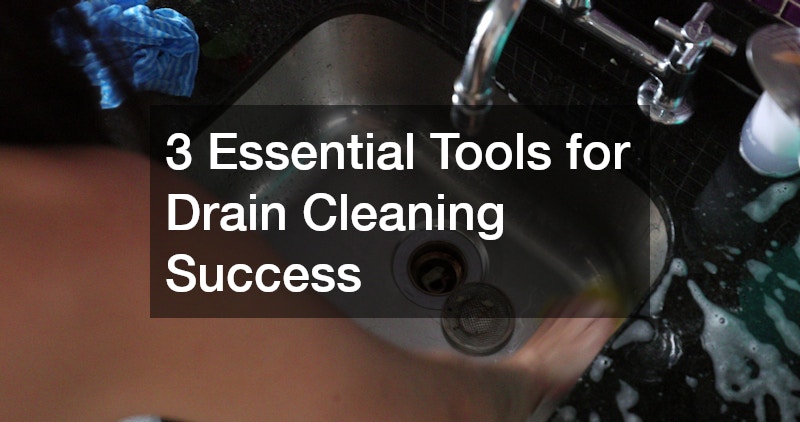Understanding the importance of utilizing the right tools for effective drain cleaning can save time, effort, and potentially avoid further plumbing issues. Proper tools not only make the task more manageable but also prevent damage to your plumbing system by addressing clogs efficiently. In this article, we explore the three essential tools that every homeowner or professional should have to ensure their drain cleaning endeavors are successful.
What are the best tools for unclogging drains?
Plunger: Your First Line of Defense
A plunger is often the first tool people reach for when confronting a clog, and for good reason. It’s simple to use, inexpensive, and can effectively clear minor blockages with minimal effort. A standard cup plunger is ideal for sinks and tubs, while a flange plunger is better suited for toilets, as its extension enhances the seal and maximizes suction.
Drain Snake: Navigating Through Tough Clogs
A drain snake, or auger, is a versatile tool that can reach deeper into pipes to break up stubborn clogs. There are manual and motorized versions, each offering unique benefits depending on the severity and location of the blockage. For most homeowners, a handheld model can suffice, while professionals may opt for a power-operated snake to tackle more challenging tasks.
Hydro Jet: Powering Through Stubborn Blockages
The hydro jet is a powerful tool that uses high-pressure water to clear clogs and clean the inside of pipes. This method is often used by professionals due to its effectiveness in clearing stubborn blockages that other tools may struggle with. Hydro jetting is especially beneficial for removing mineral buildup, grease, and roots that infiltrate plumbing systems.
How do you choose the right drain cleaning tool for your needs?
Assessing the Type and Severity of Clog
Choosing the right tool begins with accurately diagnosing the issue at hand. Minor clogs can often be handled with a plunger, while more severe blockages might require a drain snake or hydro jet. Assessing factors like the speed of water drainage, location of the clog, and frequency can guide your decision in selecting the most appropriate tool.
Different types of clogs respond better to specific tools; for example, hair clogs might be best addressed with a snake, whereas grease may require the power of a hydro jet. Understanding what is causing the blockage will inform the tool choice, enhancing the likelihood of success. Inspection cameras can also help visually pinpoint the issue, especially in inaccessible areas.
Tool Compatibility with Your Plumbing System
Understanding your plumbing system is crucial when choosing a drain cleaning tool. Different materials and pipe designs may influence which tool is safe to use without causing damage. Modern plumbing systems might handle aggressive tools better than older setups, where caution is advisable to prevent cracks or leaks.
Cost and Maintenance Considerations
Budgeting for drain cleaning tools involves considering both initial costs and long-term maintenance expenses. While a plunger is relatively cheap and easy to maintain, power tools like snakes and hydro jets require more of an investment and ongoing care. Balancing cost against expected frequency of use and effectiveness forms the cornerstone of smart purchasing decisions.
Regular maintenance, such as cleaning and lubrication, can prolong the lifespan of more complex tools, preventing additional costs down the line. Investing in high-quality tools might require more upfront, but the reliability and durability often offset more affordable, less efficient options. Proper storage conditions are integral in maintaining tool integrity and function.
How can you maintain tools for effective drain cleaning?
Regular Cleaning and Storage Tips
Maintaining your drain cleaning tools through regular cleaning and proper storage is essential to ensure their effectiveness and longevity. After each use, clean tools like plungers and drain snakes with a disinfectant to avoid bacteria build-up and bad odors. Dry them thoroughly to prevent rust, particularly on metal components, and store them in a location that is dry and free of drastic temperature fluctuations.
Recognizing Wear and Tear
Regular inspections for wear and tear are paramount to maintaining safe and functional tools. Rust, cracks, and any visible damage can compromise both usability and safety, making early detection crucial. Look out for signs such as sluggish performance, leaks, or unusual sounds that might indicate malfunction and necessitate repair or replacement.
Develop a periodic schedule to examine tools, accounting for usage frequency and conditions under which they are operated. While some wear is inevitable, diligent oversight facilitates informed decisions on whether to fix a tool or replace it entirely, preserving both safety and efficiency. Where repair seems prudent, sourcing genuine parts guarantees tool integrity and aligns with performance expectations.
Professional Servicing and Calibration
Equip yourself with the right tools, and you’ll be prepared to tackle any drain cleaning challenge that comes your way. By understanding the importance of each tool, how to choose the right one, and maintaining them properly, you’ll ensure efficiency and longevity in your plumbing solutions. With the proper knowledge and equipment, effective drain maintenance becomes not only manageable but also a cost-saving endeavor.




